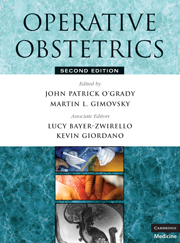Preface
Published online by Cambridge University Press: 07 May 2010
Summary
Obstetrics is not one of the exact sciences, and, in our penury of truth we ought to be accurate in our statements, generous in our doubts, tolerant in our convictions.
James Young Simpson (1811–1870)MUCH TO OUR SURPRISE, more than ten years have passed since the publication of the first edition of Operative Obstetrics. Since the initial text appeared in 1995, new tests, surgical procedures, and novel methods of medical education have been introduced to the practice of obstetrics. In addition, there has been an expansion of roles for nonphysician personnel in the provision of care to pregnant women. There remain important unresolved controversies in the specialty, including elective or patient-choice cesarean delivery, trials of vaginal birth after cesarean, patient safety during hospitalization, pregnancy termination, and the recruitment and training of new practitioners, to list only a few. The influx of new ideas and the development of new techniques over the last decade have accompanied increasing demands by institutions, third-party payers, and governmental agencies for evidence-based, cost-efficient, and safe practice. Clinicians are thus pressured from many directions to rapidly incorporate new scientific advances into their management, rethink traditional concepts of best practice, follow increasingly restrictive protocols and practice guidelines, and even revisit basic ethical concepts. Because of the unresolved issues concerning appropriate practice and the risks associated with adverse outcomes, it is inevitable that medicolegal risks in obstetrics remain high and that increasingly few clinicians, with a decade or more of active practice, now escape litigation.
- Type
- Chapter
- Information
- Operative Obstetrics , pp. xiii - xivPublisher: Cambridge University PressPrint publication year: 2008



